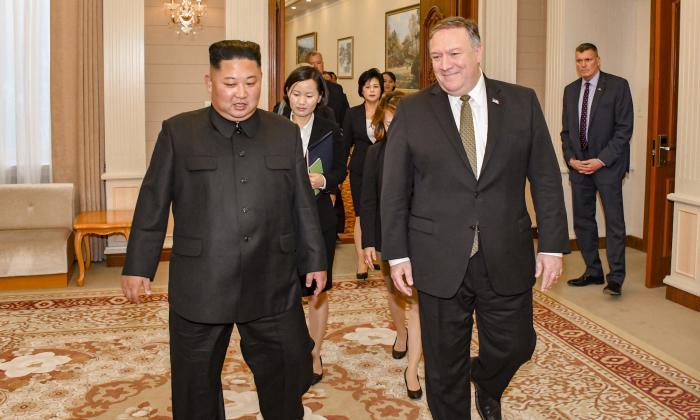SEOUL—North Korean leader Kim Jong Un and U.S. Secretary of State Mike Pompeo agreed to arrange a second leaders summit “as soon as possible,” and discussed potential U.S. monitoring of Pyongyang’s steps toward denuclearization, South Korea’s presidential office said on Oct. 7.
Pompeo said his latest, fourth trip to Pyongyang was “another step forward” to denuclearization and he had a “good, productive conversation” with Kim, but more needed to be done.
South Korean President Moon Jae-in held talks with Pompeo in Seoul after the top U.S. diplomat met with Kim for more than three hours during a short trip to Pyongyang that was aimed at breaking a gridlock in their nuclear negotiations.
Pompeo said he and Kim discussed denuclearization steps to be taken by the North and the issue of U.S. government monitoring of those actions, which Washington sees as vital, as well as the measures the United States would conduct in return, Moon’s office said.
In a statement, State Department spokeswoman Heather Nauert said Kim had invited inspectors to visit the Punggye-ri nuclear test site to confirm it has been irreversibly dismantled. The statement did not provide further details.
Pompeo and Kim also agreed to form a working group “at an early date” to discuss the denuclearization process and the second summit, which Kim proposed to U.S. President Donald Trump in a letter last month, according to Moon’s press secretary Yoon Young-chan.
“Secretary Pompeo said he and Chairman Kim concurred that they will hold the second U.S.–North Korea summit as soon as possible,” Yoon said in a statement.
The two had “refined options” for a location and date of a second summit without offering specifics, the State Department statement said.
While Seoul sounded upbeat, Pompeo struck a more cautious tone.
“As President Trump said, there are many steps along the way and we took one of them today,” Pompeo told Moon. “It was another step forward. So this is, I think, a good outcome for all of us.”
Trump appeared hopeful on Oct. 7.
“[Mike Pompeo] had a good meeting with Chairman Kim today in Pyongyang. Progress made on Singapore Summit Agreements! I look forward to seeing Chairman Kim again, in the near future,” Trump wrote on Twitter.
Moon expressed hopes that Pompeo’s trip and the proposed second meeting between Kim and Trump would make “irreversible, decisive progress in terms of denuclearization as well as the peace process.”
Moon had his own third summit with Kim last month in Pyongyang, which was partly intended to help salvage the stumbling negotiations between Pyongyang and Washington, after Trump called off Pompeo’s planned visit to the North in late August citing lack of progress.
A U.S. official who was part of Pompeo’s delegation said the trip was “better than the last time” but added: “It’s going to be a long haul.”
Kim pledged to work toward denuclearization during the Singapore summit, but Pyongyang’s actions have since fallen short of U.S. demands for irreversible steps to give up its arsenal.
At his last meeting with Moon, he expressed willingness to allow outside observations of key missile facilities and, for the first time, to “permanently” scrap North Korea’s main nuclear complex in Yongbyon.
But the inter-Korean agreement again failed to stipulate any plans called for by the United States, such as to declare a list of its nuclear weapons, facilities, and materials, or a concrete timeline for denuclearization.
The United Nation’s nuclear watchdog, the International Atomic Energy Agency (IAEA), say they are best placed to verify a dismantlement of North Korea’s nuclear program. They have not returned to North Korea since they were expelled in 2009.
The IAEA said in August it did not find any indication that North Korea had stopped its nuclear activities, adding to doubts about the country’s willingness to abandon its arsenal.






Friends Read Free